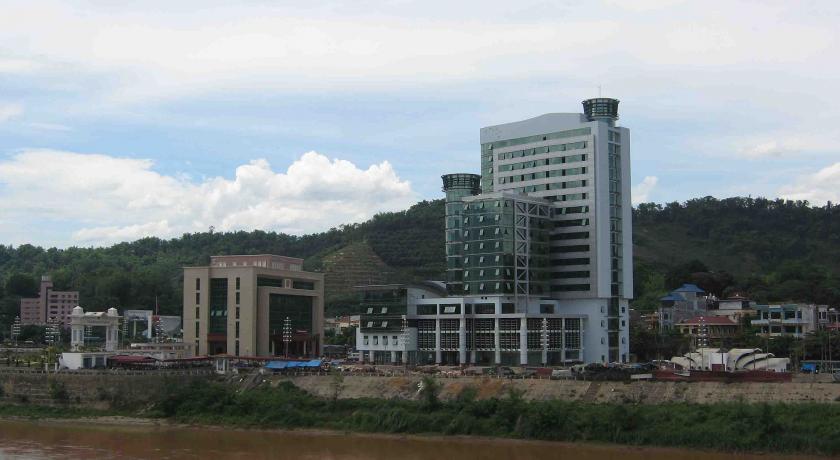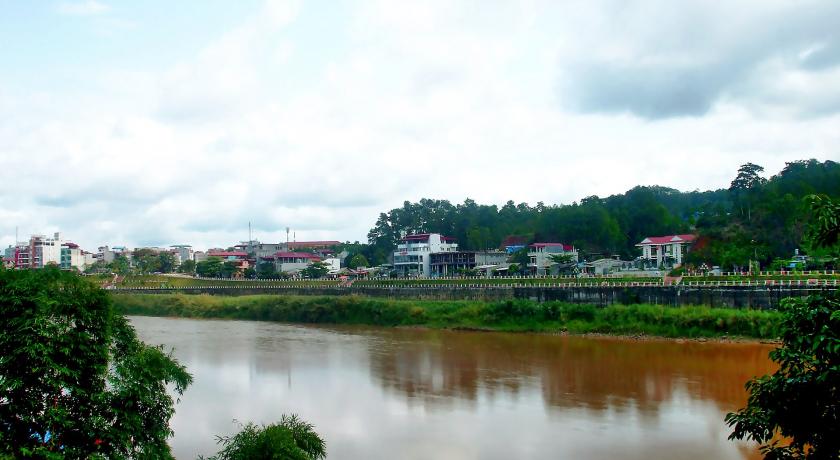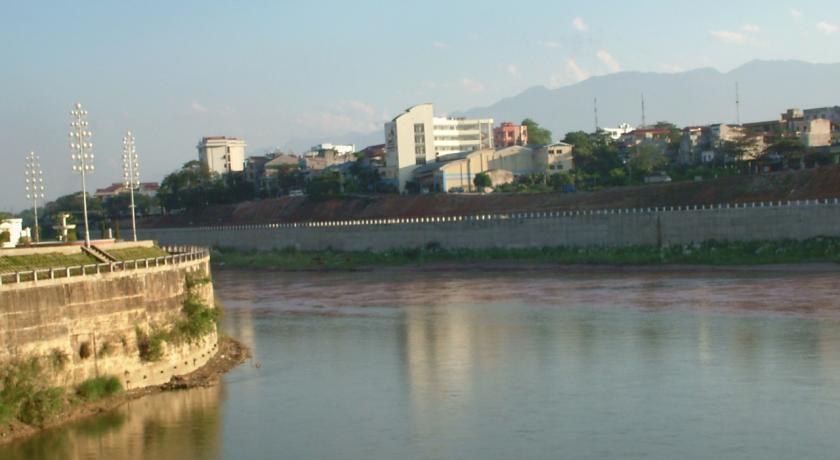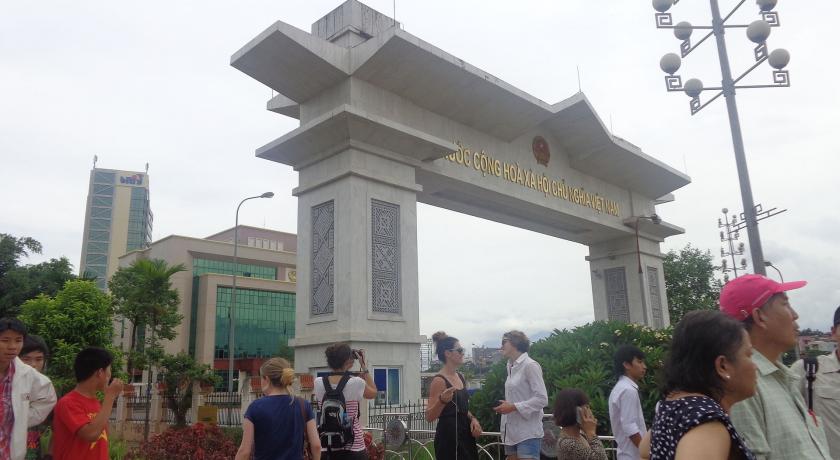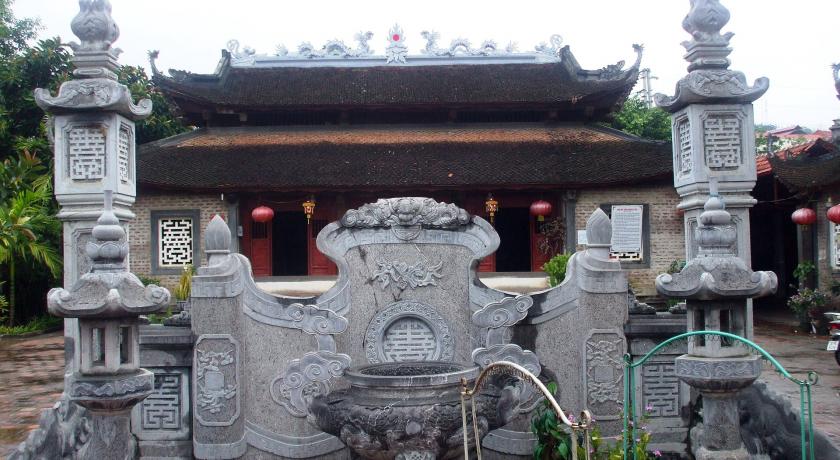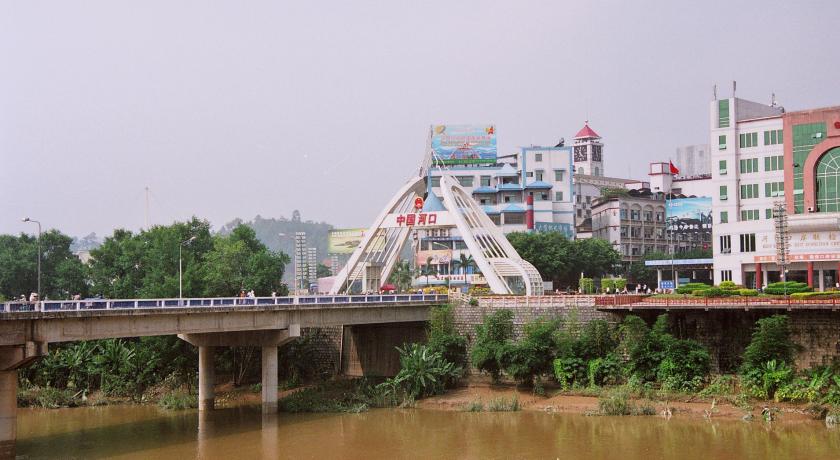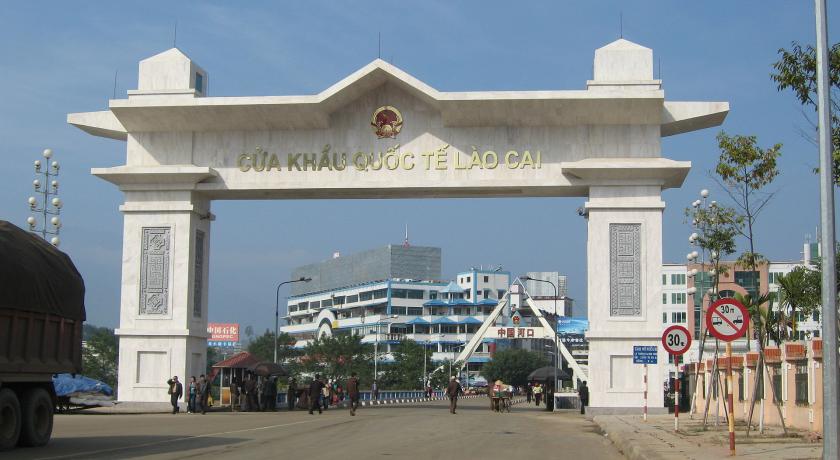Description
Lào Cai city is the capital of Lào Cai Province in the Northwest region of Vietnam.
The city borders the city of Hekou Yao Autonomous County, in the Yunnan province of south-west China. It lies at the junction of the Red River (Sông Hồng) and the Nanxi River (Yunnan) approximately 160 miles (260 km) northwest of Hanoi.
It is a market town for timber, and the Lào Cai Railway Station is located on the Hải Phòng railway to Yunnan Province in China.
The Lào Cai border town on the banks of the Red River, as the provincial capital has now prospered in view of large trade with China and is a booming city with a community of many rich millionaires. Since 2006, Lào Cai has the status of a city, is the largest town in the region and strategically very important. An airport is planned to be built by 2020.
Demographics (population)
As of 2009 the district had a population of 98, 363. The district covers an area of 229.67 km² (88.68 sq mi)
Ethnic minorities in Lao Cai used to speak Southwestern Mandarin to each other when their languages were not mutually intelligible.
History
Lào Cai has been known since ancient times as a historic trading post. Here, the Chinese, the Vietnamese and the ethnic minorities of the region fought to gain control. In 1463, the Viet Kings established Lào Cai as the capital of their northernmost region, then named as Hưng Hóa. It came under French colonial rule in 1889 and was their administrative town, and also served as a military garrison. In the early 19th century the first railway line was built from Hanoi to this region. It took 7 years to complete but at the cost of 25,000 lives of Vietnamese conscripted labour.
The town was invaded by the Chinese in 1979 and the border was closed and not reopened until 1993. The town has a carbide factory.
Transport network
The Lao Cai train station, part of the line of Yunnan, is the point of descent tourists to Sa Pa. The station is served many times a day from Hanoi. An airport has been proposed to be built at Lao Cai in the next five years.
Tourism
Lào Cai has many historic sites, natural caves and produces agricultural specialties such as Bắc Hà plums. The markets in Lào Cai are extremely colourful places because of the fresh variety of produce on sale and the beautiful traditional dresses donned by the Flower Hmong people. While the main economic activity here is agriculture, which is dependent on the many rivers for irrigation, the villagers have taken advantage of the increasing tourist crowd to earn extra income through handicraft trade and homestay experiences.
Sa Pa
A lot of tourists use Lào Cai as a hopping of point on the way to Sa Pa which is one of 21 national tourism areas in Vietnam. Sa Pa is at an altitude of 1,200–1,800 metres (3,900–5,900 ft), has a mild climate throughout the year, lush, forested and mountainous scenery, waterfalls. A visit to Sapa town is said to be more popular among visitors from Western countries in view of its attraction of ethnic tribes.
A popular motor biking route among tourists that covers the mountainous region of the province known as the "Tonkinese Alps" starts from the White Thai villages, Sơn La, historic site of Dien Bien Phu and terminates at Sa Pa.
Accommodation
Listed here is some of the accommodation in Lao Cai, there is a large selection of hotels in nearby Sa Pa.
Sapaly Hotel: Address, 15 Nguyễn Huệ, Lào Cai, Vietnam
Phone: +84 20 3666 222
Lao Cai Star Hotel: Số 03 Hoàng Liên, Cốc Lếu, tp. Lào Cai, Vietnam
Phone: +84 20 3823 328
Lao Cai Galaxy Hotel: Address, 268 Minh Khai, Phố Mới, Lao Cai, Lào Cai, Vietnam
Phone: +84 98 812 16 31
Kim Cương Hotel: 358 Nguyễn Huệ, Phố Mới, tp. Lào Cai, Lào Cai, Vietnam
Phone: +84 20 3860 999
Banks & Shopping
There are a couple of ATMs in Lao Cai. The Techcom Bank has ATMs on the square of the train station as well as close to the border. However, they accept only some international cards. There is one ATM accepting all international cards but it's neither close to the border nor to the railway station. Motorbike drivers usually know it and will drive you there (one-way 10'000d)
As soon as you leave the immigration building you will be approached by money changers. They usually offer poorer exchange rates than the bank. There are two banks just next to the border and a third one just at the other end of the first bridge, though these are all annoyingly closed at weekends. Banks in Hanoi will also readily exchange your RMB for Dongs.
Internet
You can get free wifi near bus/train station at the Fansipang restaurant and Le Bordeaux Restaurant, both are visible from the station.
Get in
From Hanoi
Trains run from Hanoi to Lao Cai. One train starts at about 6 am and arrives about 6 pm. There's a simple restaurant on the train. People are selling food through the windows or walking through the train during stops around lunch time. There are 220 Volt / 50 Hz power outlets in the soft seat coaches.
There are several night trains each day to and from Hanoi (about 9h, 20$ for a soft sleeper depending on the train). Check time table at https://vietnam-railway.com/train/hanoisapatimetable
Including the Orient Express; if you want a bit more comfort.
From China
Buses run from Kunming and other cities in Yunnan (China) to Hekou from where it is a short walk over the border to Lao Cai.
Border crossing
The Lao Cai / Hekou border is open every day from 07:00 to 22:00( Vietnamese Time). Although in theory some nationalities can get their visas on arrival, there is precious little information or assistance available at the gate so it makes sense to arrive with a visa in your passport in any case. Going the other way, (travelling to Vietnam), no visa on arrival is available.
The border is open from (8am to 11pm Chinese time). Crossing the border is pretty easy and fast. Just be careful on the Vietnamese side of the border you might be asked to fill in some 'health form', exchange money, book a taxi, etc... by people who seems to be immigration workers. This is a scam, you will lose a lot money if you agree. Don’t give them any bribes and don’t use their services. Just ignore them, get your entry stamp and leave the immigration post building. It is 2 km to the bus/train station, 30,000 dong by car taxi.
Get out
Lao Cai does have both, public bus, and train station - together they constitute the center of town. While the train station can be found right next to the main road, the bus station is situated around 300m south-west of it, down Phan Đình Phùng. Additionally, mini buses are abundant (destinations usually indicated behind wind shield), which will drive around town until full and can be flagged down - prices are fixed but conductors usually try their luck and ask for more, including mock tickets with fake prices.
Hanoi
There are both daytime and overnight sleeper trains between Hanoi & Lao Cai, and on the sleeper trains you can choose between the normal Vietnamese railways sleepers or a whole series of privately-run sleeping-cars of a higher standard aimed at tourists.
Trains run from the train station in Lao Cai to Hanoi - with the option of an overnight sleeper. This will however put you in Hanoi rather early with the only company being a million motorcycle and taxi touts. So it’s generally a good idea to have a plan as to where you will be heading to on arrival to avoid being scammed. Prices for a soft sleeper ticket are around 300,000 dong, lower classes are cheaper. Check http://www.seat61.com/Vietnam.htm for up to date information on prices.
There is also a bus service to Hanoi costing 89'000 dong.
Night bus to Hanoi. Costs about 150,000 dongs. Very uncomfortable with loud music and no leg space. Train is much better option, but often needs to be booked in advance.
Sapa
If you want to head for the hills at Sapa, the best way to get there is to take the train from Hanoi to Lao Cai. Sapa has no railway station, but it's about 38 km (24 miles) from Lao Cai railway station and easily reached from there by bus, jeep or taxi in about 50 minutes.
As of August 2014 there is a public bus service from Lao Cai to Sapa for 28,000d per person, leaving from the train station at 7:30, 8:30, 9:30, 10:30, 11:30, 12:30, 13:30, 14:30, 15:00, 15:30, 17:30. The station is clearly marked "buses to Sapa" in the train station parking lot, and the buses are white, yellow and red. If you're carrying a large bag you might be asked for an additional 15,000d. Note that this is an extremely bumpy ride, and many passengers tend to get sick - the staff offers plastic bags, water and moist towels to the passengers.
If arriving via the Chinese Hekou border, watch out for touts who will persistently attempt to get you to pay anything up to 150'000d, or ¥20 (approx 50'000d) per person to get to Sapa. Just ignore them and walk to a main street and flag a minibus with a sign showing Sa Pa at the windscreen. Confirm with the driver or bus attendant 50'000d and hop into the minibus to Sapa.
If arriving by train (usually at around 5am - 6am) watch out for minibus scams asking for 200,000 dong upwards. Generally they can still be bargained down (despite much disgust from whoever is so kindly scamming you).
Bac Ha
Bac Ha, with its Sunday market, can be reached via public bus from the Lao Cai Bus station in around 2.5 - 3 hours for 60, 000 dong
To, Hekou --- Kunming China
About 40min walk from bus/train station, is the border crossing to Hekou in China. Border office is a big building next to a bridge, opposite Sapaly hotel / Biti's trade center. From here you can catch an onward bus through to Kunming for around Y120.
If you’re taking the train out of Hekou, be sure to book ahead. ESPECIALLY during Chinese holiday times – book your train in advance. You can now do this online with CTrip. Seats open up to 60 days in advance.
There’s no visa on arrival in China. The nearest embassy is in Hanoi. Visa: The visa application process can be arduous and paperwork intensive – plan plenty of time to put your application in.
Note: prices shown from 2014
Note: Typhoon Nida between 02 and 05 August 2016 triggered flash floods and landslides in the north western province of Lao Cai, Vietnam. The rain also increased levels of the Red River, causing flooding in several areas. August 5 2016, Lao Cai province was subject to flash flooding, According to initial reports, over 50 households in Lao Cai City were deeply submerged under the floodwaters. The 4D National Route connecting Lao Cai City and Sa Pa District in the province was cut off by the flood as many sections were submerged underwater or blocked by landslides, said Do Trong Nguyen, deputy head of the Sa Pa Division of Culture and Information. Please check with your tour operator for updates on road conditions & travel in this area.
Source https://en.wikipedia.org/wiki/L%C3%A0o_Cai
Address
Lào Cai
Vietnam
Lat: 22.445882797 - Lng: 104.003776550


